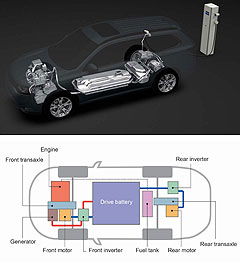Future models - Mitsubishi - Outlander - PHEVParis show: Mitsubishi plug-in Outlander does 880kmLong-distance runner: Mitsubishi’s all-new Outlander PHEV can run on battery power for about 55km, and then on petrol power for more than 800km. Hybrid Mitsubishi Outlander PHEV details emerge ahead of Paris motor show6 Sep 2012 MITSUBISHI has confirmed powertrain details of its pioneering petrol-electric plug-in hybrid Outlander PHEV that will be revealed in the flesh at the Paris motor show late this month, saying its target range is “at or greater than 880km” – further than many conventional vehicles. It has also revealed that the Outlander range will debut a range of high-end safety features, including a radar-based autonomous braking system – a first for the Japanese company. As GoAuto reported last month, Mitsubishi Motors Australia Ltd (MMAL) expects the Outlander PHEV to be cheaper than Holden’s $59,990 Volt, replacing the current V6 Outlander flagship in the all-new compact SUV range. The new-generation petrol and – for the first time – diesel-powered variants will open the Outlander batting in the Australian market in November, about six months ahead of the plug-in hybrid (PHEV) range-topper that is expected Down Under in mid 2013. As expected, the Outlander PHEV – which was called PX-MiEV in its concept form – will score a fuel economy combined cycle reading of about 1.6 litres per 100km, compared with the smaller and more aerodynamic Holden Volt’s 1.2L/100km. The all-wheel-drive Mitsubishi has an all-electric range of about 55km, compared with the Volt’s 87km, before running on petrol power to about 880km (Volt does about 600km).  Left: Mitsubishi Outlander PHEV. Left: Mitsubishi Outlander PHEV.Unlike the range-extender Volt, which is effectively an electric car with a back-up petrol-driven generator, the Outlander PHEV can drive the wheels with electric power, petrol power or a combination of both. The world’s first plug-in hybrid SUV, the Outlander PHEV borrows electrical components from the Mitsubishi i-MiEV pure electric vehicle, combining two 60kW electric motors – one at the front and one at the rear – with a 70kW 2.0-litre four-cylinder petrol engine hooked up to a generator. The Outlander PHEV operates in three modes. In EV Mode, the front and rear motors drive the vehicle using only electricity from the 12kWh lithium-ion battery, producing zero tailpipe emissions. In Series Hybrid Mode, the petrol engine operates as a generator to supply electricity when the battery charge falls below a predetermined level or when more powerful performance is required. At highway speeds, Parallel Hybrid Mode shifts the petrol engine into the main drive role, providing most of the motivation via the front wheels, assisted by the electric motors as required. The driver can switch on the petrol engine at any time to recharge the battery when stationary or on the move. Mitsubishi says the twin motor set up to drive the front and rear wheels not only saves friction compared with a single motor but also delivers four-wheel-drive performance with “better response and finer control than conventional mechanical systems”. “It accomplishes this without a propeller shaft or other mechanical components seen in conventional mechanical systems,” the company’s blurb says. Mitsubishi says the high-torque characteristics of electric motors provide acceleration comparable to a high-output internal combustion engine. The battery can be fully recharged in four and a half hours from a 15-amp outlet, or just 30 minutes on a quick charger. Like the i-MiEV electric car, 10-amp recharging from a standard Australian-style household plug appears to be unavailable, unlike the system in the Holden Volt. Mitsubishi has also announced its Outlander will be equipped with an array of active safety systems, although not all will be across the range or available from launch in November. In Europe, the systems will come under the e-Assist umbrella, and include adaptive cruise control, autonomous braking – called Forward Collision Mitigation System by Mitsubishi – and lane departure warning. MMAL corporate communications manager Caitlin Beale said the systems would be included on the new Outlander for Australia, but initially on high-spec models. She said the lane departure warning system would not arrive until about the middle of 2013, about the same time as the Outlander PHEV. The systems use a combination of radar beamed from a unit in the grille and a video camera behind the windscreen to keep the Outlander from potential disaster. The radar system warns the driver of a sudden decrease in speed of a vehicle on the road ahead, issuing an audible alert. If the driver does not brake, the system can automatically apply the brakes to minimise the chances of severe impact. The lane departure warning system uses the camera to detect unintentional lane drift, but can be switched off when driving on narrow lanes or in urban areas.  Read moreOutlander pricing
Motor industry news |
Click to shareMitsubishi modelsResearch Mitsubishi Outlander pricing
Motor industry news |
















Facebook Twitter Instagram